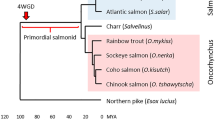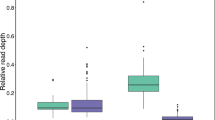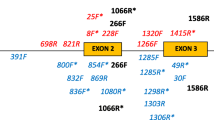Abstract
Using a bacterial artificial chromosome (BAC) library, we analysed a 99.5 kb genomic segment containing the major histocompatibility class II genes of a teleost, the three-spined stickleback Gasterosteus aculeatus. Experiments with G. aculeatus have provided direct evidence for balancing selection by pathogens and mate choice driving MH class II beta polymorphism. Two sets of paralogous class II alpha genes and beta genes in a tandem arrangement were identified, designated Gaac-DAA/DAB and Gaac-DBA/DBB. Expression analysis of the beta genes using single-strand conformation polymorphism revealed that both gene copies are expressed. Based on an analysis of pairwise nucleotide polymorphisms, we estimate that the duplication into two paralogous class II loci occurred only 1.2–2.4 million years ago, 1–2 orders of magnitude more recently than in other fish, bird or mammalian species. At the 3′-direction of the classical MH loci, we identified another seven genes or gene fragments, two of which (small inducible cytokine, complement regulatory factor) are related to immune function in other vertebrates. None of these genes were associated with MH class II genes in zebrafish, suggesting a markedly different organisation of the MH class II region in sticklebacks, and presumably, across bony fishes. When the nucleotide substitution pattern of the novel class II beta genes was analysed together with a representative sequence sample isolated from fish in northern Germany (n=27), we found that the peptide binding region of the Gaac-DAB and Gaac-DBB loci had undergone an inter-locus gene conversion (P=0.007). In accordance, we found a 10- to 20-fold higher frequency of CpG-islands on the MH class II segment compared to other species, a feature that may be conducive for inter-locus recombination.


Similar content being viewed by others
References
Aeschlimann PB, Häberli MA, Reusch TBH, Boehm T, Milinski M (2003) Female sticklebacks Gasterosteus aculeatus use self-reference to optimize MHC allele number during mate choice. Behav Ecol Sociobiol 54:119–126
Antequera F (2003) Structure, function and evolution of CpG island promoters. Cell Mol Life Sci 60:1647–1658
Binz T, Reusch TBH, Wedekind C, Milinski M (2001) SSCP analysis of Mhc class IIB genes in the threespine stickleback. J Fish Biol 58:887–890
Brown JH, Jardetzky TS, Gorga JC, Stern LJ, Urban RG, Strominger JL, Wiley DC (1993) Three-dimensional structure of the human class II histocompatibility antigen HLA-DR1. Nature 364:33–39
Dawkins R, Leelayuwat C, Gaudieri S, Tay G, Hui J, Cattley S, Martinez P, Kulski J (1999) Genomics of major histocompatibility complex: haplotypes, duplication, retroviruses and disease. Immunol Rev 167:275–304
Dixon B, Erp S, van Rodrigues PN, Stet RJM (1995) Fish major histocompatibility complex genes: an expansion. Dev Comp Immunol 19:109–133
Dixon B, Nagelkerke LAJ, Sibbing FA, Egberts E, Stet RJM (1996) Evolution of MHC class II b chain-encoding genes in the Lake Tana barbel species flock (Barbus intermedius complex). Immunogenetics 44:419–431
Eizen JA, Fraser CM (2003) Phylogenomics: intersection of evolution and genomics. Science 300:1706–1707
Figueroa F, Mayer WE, Sültmann H, O’Huigin C, Tichy H, Satta Y, Takezaki N, Takahata N, Klein J (2000) Mhc class II B gene evolution in East African cichlid fishes. Immunogenetics 51:556–575
Flajnik MF, Kasahara M (2001) Comparative genomics of the MHC: glimpses into the evolution of the adaptive immune system. Immunity 15:351–362
Goldstein DB, Schlötterer C (1999) Microsatellites. Evolution and applications. Oxford University Press, New York
Hess CM, Edwards SV (2002) The evolution of the major histocompatibility complex in birds. Bioscience 52:423–431
Högstrand K, Böhme J (1994) A determination of the frequency of gene conversion in unmanipulated mouse sperm. Proc Natl Acad Sci USA 91:9921–9925
Högstrand K, Böhme J (1999) Gene conversion of major histocompatibility complex genes is associated with CpG-rich regions. Immunogenetics 49:446–455
Hughes AL (2000) Evolution of introns and exons of class II major histocompatibility complex genes of vertebrates. Immunogenetics 51:473–486
Hughes AL, Nei M (1988) Pattern of nucleotide substitution at major histocompatibility complex class I loci suggests overdominant selection. Nature 335:167–170
Klein J (1986) Natural history of the major histocompatibility complex. Wiley, New York
Kruiswijk CP, Hermsen T, Fujiki K, Dixon B, Savelkoul HFJ, Stet RJM (2004) Analysis of genomic and expressed major histocompatibility class Ia and class II genes in a hexaploid Lake Tana African ‘large’ barb individual (Barbus intermedius). Immunogenetics 55:770–781
Kumar S, Tamura K, Jakobsen IB, Nei M (2001) MEGA2: Molecular genetics analysis software. Arizona State University, Tempe
Kuroda N, Figueroa F, O’Huigin C, Klein J (2002) Evidence that the separation on Mhc class II from class I loci in the zebrafish, Danio rerio, occurred by translocation. Immunogenetics 54:418–430
Landry C, Garant D, Duchesne P, Bernatchez L (2001) Good genes as heterozygosity: the major histocompatibility complex and mate choice in Atlantic salmon (Salmo salar). Proc R Soc Lond B 268:1279–1285
Langefors Å, Lohm J, Grahn M, Andersen Ø, von Schantz T (2001a) Association between major histocompatibility complex class IIB alleles and resistance to Aeromonas salmonicida in Atlantic salmon. Proc R Soc Lond B 268:479–485
Langefors Å, Lohm J, von Schantz T (2001b) Allelic polymorphism in MHC class II B in four populations of Atlantic salmon (Salmo salar). Immunogenetics 53:329–336
Malaga-Trillo E, Zaleska-Rutczynska Z, McAndrew B, Vincek V, Figueroa F, Sültmann H, Klein J (1998) Linkage relationships and haplotype polymorphism among cichlid Mhc class II B loci. Genetics 149:1527–1537
Martinsohn JT, Sousa AB, Guethlein LA, Howard JC (1999) The gene conversion hypothesis of MHC evolution: a review. Immunogenetics 50:168–200
Matsuo MY, Asakawa S, Shimizu N, Kimura H, Nonaka M (2002) Nucleotide sequence of the MHC class I genomic region of a teleost, the medaka (Oryzias latipes). Immunogenetics 53:930–940
MHC Sequencing Consortium (1999) Complete sequence and gene map of a human major histocompatibility complex. Nature 401:921–923
Nonaka M, Matsuo MY, Naruse K, Shima A (2001) Comparative genomics of Medaka: the major histocompatibility complex (MHC). Mar Biotechnol 3:S141–S144
Ohta T (1999) Effect of gene conversion on polymorphic patterns at major histocompatibility complex loci. Immunol Rev 167:319–325
Penn D, Potts WK (1999) The evolution of mating preferences and major histocompatibility complex genes. Am Nat 153:145–164
Penn DJ, Damjanovich K, Potts WK (2002) MHC heterozygosity confers a selective advantage against multiple strain infections. Proc Natl Acad Sci USA 99:11260–11264
Phillips RB, Zimmerman A, Noakes MA, Palti Y, Morasch MRW, EIben L, Ristow SS, Thorgaard GH, Hansen JD (2003) Physical and genetic mapping of the rainbow trout major histocompatibility regions: evidence for duplication of the class I region. Immunogenetics 55:561–569
Piontkivska H, Nei M (2003) Birth-and death evolution in primate MHC class I genes: divergence time estimates. Mol Biol Evol 20:601–609
Posada D (2002) Evaluation of methods for detecting recombination from DNA sequences: empirical data. Mol Biol Evol 19:708–717
Reusch TBH, Häberli MA, Aeschlimann PB, Milinski M (2001) Female sticklebacks count alleles in a strategy of sexual selection explaining MHC polymorphism. Nature 414:300–302
Richardson DS, Westerdahl H (2003) MHC diversity in two Acrocephalus species: the outbred great reed warbler and the inbred Seychelles warbler. Mol Ecol 12:3523–3529
Richman AD, Herrera LG, Nash D (2001) MHC class II beta sequence diversity in the deer mouse (Peromyscus maniculatus): implications for models of balancing selection. Mol Ecol 10:2765–2773
Richman AD, Herrera LG, Nash D, Schierup MH (2003) Relative roles of mutation and recombination in generating allelic polymorphism at an MHC class II locus in Peromyscus maniculatus. Genet Res Camb 82:89–99
Sambrook JG, Russell R, Umrania Y, Edwards YJK, Campbell RD, Elgar G, Clark MS (2002) Fugu orthologues of human major histocompatibility complex genes: a genome survey. Immunogenetics 54:367–380
Sato A, Figueroa F, O’Huigin C, Steck N, Klein J (1998) Cloning of major histocompatibility complex (MHC) genes from threespine stickleback, Gasterosteus aculeatus. Mol Mar Biol Biotechnol 7:221–231
Sato A, Figueroa F, Murray BW, Malaga-Trillo E, Zaleska-Rutczynska Z, Sültmann H, Toyosawa S, Wedekind C, Steck N, Klein J (2000) Nonlinkage of major histocompatibility complex class I and II loci in bony fishes. Immunogenetics 51:108–116
Sawyer SA (1999) Geneconv: a computer package for statistical detection of gene conversion. Department of Mathematics, Washington University. http://www.math.wustl.edu/sawyer
Shum BP, Guethlein LA, Flodin LR, Adkinson MA, Hedrick RP, Nehring RB, Stet RJM, Secombes CJ, Parham P (2001) Modes of salmon MHC class I and II evolution differ from the primate paradigm. J Immunol 166:3297–3308
Sjölander K (2004) Phylogenomic inference of protein molecular function: advances and challenges. Bioinformatics 20:170–179
Stet RJM, de Vries B, Mudde K, Hermsen T, van Heerwaarden J, Shum BP, Grimholt U (2002) Unique haplotypes of co-segregating major histocompatibility class II A and class II B alleles in Atlantic salmon (Salmo salar) give rise to diverse class II genotypes. Immunogenetics 54:320–331
Stet RJM, Kruiswijk CP, Dixon B (2003) Major histocompatibility lineages and immune gene function in fish: the road not taken. Crit Rev Immunol 23:441–471
Sültmann H, Mayer WE, Figueroa F, O’Huigin C, Klein J (1994) Organization of Mhc class II B genes in the zebrafish (Brachydanio rerio). Genomics 23:1–14
Takahashi K, Rooney AP, Nei M (2000) Origins and divergence times of mammalian class II MHC gene clusters. J Hered 91:198–204
Takai D, Jones PA (2002) Comprehensive analysis of CpG islands in human chromosomes 21 and 22. Proc Natl Acad Sci USA 99:3740–3745
Takai D, Jones PA (2003) The CpG island searcher: a new www resource. In Silico Biol 3:0021
Wegner KM, Kalbe M, Kurtz J, Reusch TBH, Milinski M (2003a) Parasite selection for immunogenetic optimality. Science 301:1343
Wegner KM, Reusch TBH, Kalbe M (2003b) Multiple parasite species are driving major histocompatibility complex polymorphism in the wild. J Evol Biol 16:224–232
Westerdahl H, Wittzell H, von Schantz T (2000) Mhc diversity in two passerine birds: no evidence for a minimal essential Mhc. Immunogenetics 52:92–100
Acknowledgements
This project was jointly funded by the Deutsche Forschungsgemeinschaft (Re 1108/4 and 1108/5, Heisenberg-Program) and the Max–Planck Society. We thank Robert Bogden (Amplicon Express) and K. Mohr and W. Zimmermann (Agowa, Berlin) for technical support and excellent cooperation, S. Liedtke for assistance and M. Milinski for continual support and encouragement.
Author information
Authors and Affiliations
Corresponding author
Rights and permissions
About this article
Cite this article
Reusch, T.B.H., Schaschl, H. & Wegner, K.M. Recent duplication and inter-locus gene conversion in major histocompatibility class II genes in a teleost, the three-spined stickleback. Immunogenetics 56, 427–437 (2004). https://doi.org/10.1007/s00251-004-0704-z
Received:
Accepted:
Published:
Issue Date:
DOI: https://doi.org/10.1007/s00251-004-0704-z




